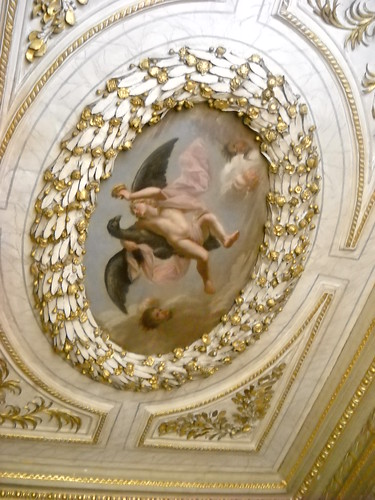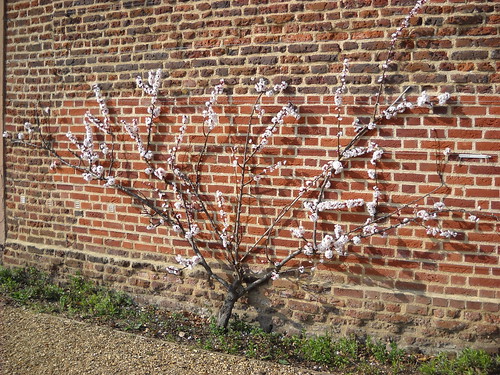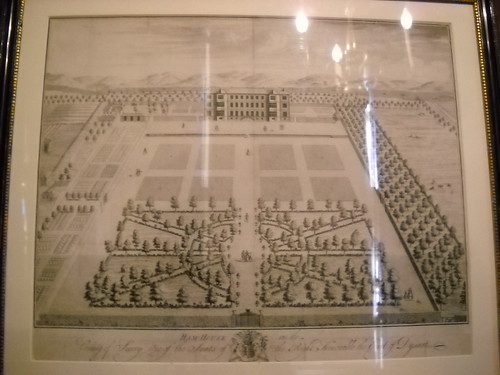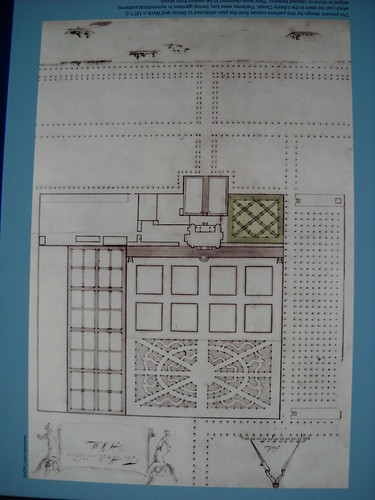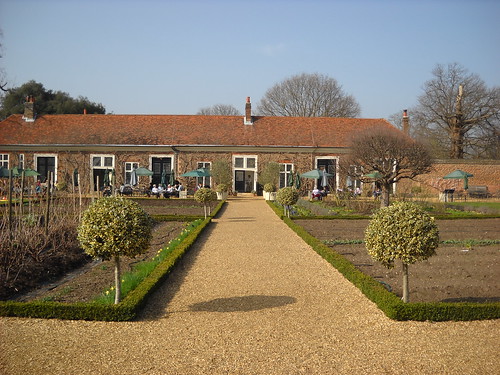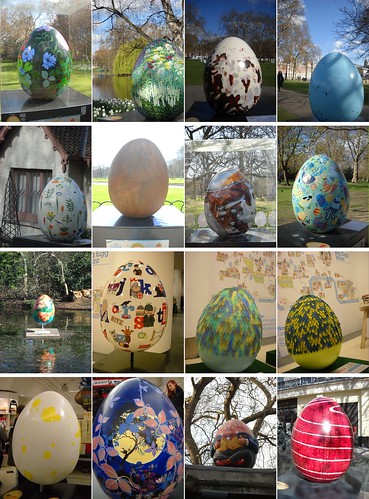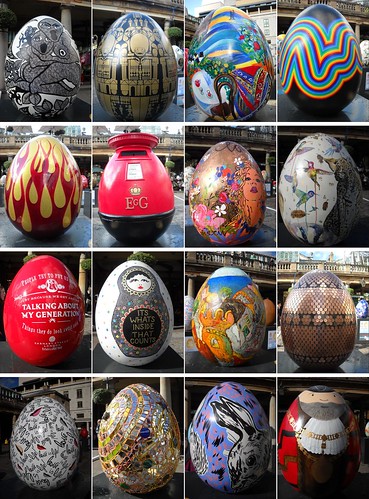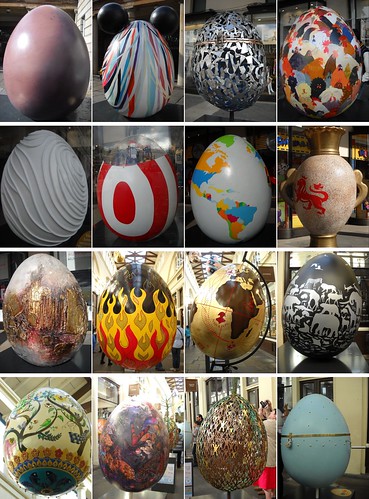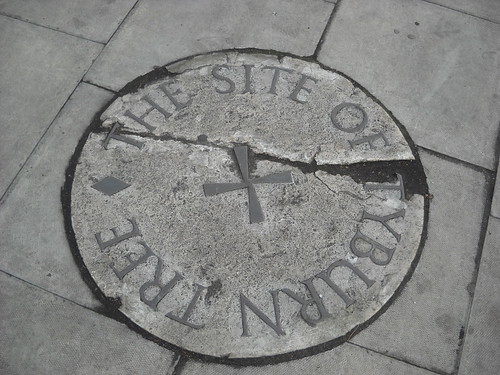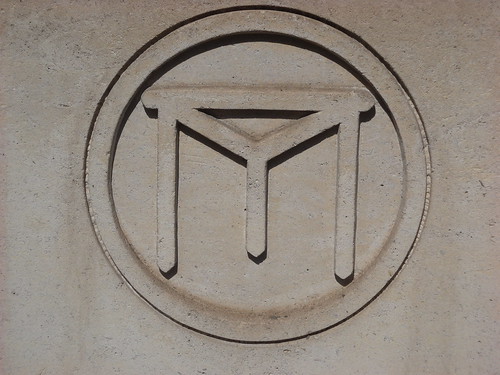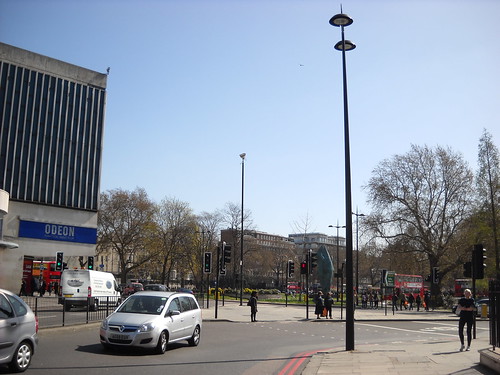For the past six months I've been researching, studying, and visiting Kensington Gardens. It's been fascinating to watch the development of its newest layer of landscape, completed as part of a multi-million pound restoration of the palace and gardens.
The new layer, designed by Todd Longstaffe-Gowan, has reunited the palace and gardens and restores the grand vistas created by Charles Bridgeman in the eighteenth century. Have a look:
21 April 2012
16 April 2012
Ham-ing It Up
I couldn't resist. *cough* Right.
After several weeks of keeping my nose in books and wrestling with computer drawing programs, I decided it was time for a break. Spring is here and I wanted a garden fix. The weather forecast looked favorable, so I decided to venture into Surrey and see Ham House. The fact that it's a well-preserved seventeenth century courtier's house with a restored period garden, which is pretty close to what my travelling heroine Celia Fiennes would have encountered in her many visits to stately homes, is mere coincidence. Even a holiday from the books can be instructive as well as enjoyable.
Being without a car, I took to public transport. Richmond, once a distant country village, is now a suburb of London and easily reached by train. Of course I tried to imagine what the countryside would have looked like 300 years ago and it's not that difficult to mentally sweep away the blocks of council flats and Victorian chimney pots to envision green pasture and woodland. And instead of arriving by train or coach, most visitors would have taken the river which was a much more common mode of transport, the Thames being the M1 of its day.
Location, location, location!
Ham House was built in 1610 by Sir Thomas Vavasour, a knight in Elizabeth I's then James I's court, and he was no fool when it came to deciding where to build a house. Situated smack on the banks of the Thames, it was within easy reach of the string of royal palaces then gracing the river, which afforded a good view whenever the royal barge happened to sail past. Plus, his job as Knight Marshal (basically, Court Police) required him to be on call at all times within a 12-mile radius of London. The location of Ham House meant that he could easily commute to work at court, at whichever palace it was the King's pleasure to hold it.
Sir Thomas died in 1620 and in 1626 Ham became the home of William Murray, 1st Earl of Dysart, who as a boy attended school with the future king Charles I. William's unfortunate lot in life was to be the prince's 'whipping boy'. Whenever little Charlie got into mischief it was William who took the punishment because, well, because they couldn't very well spank the future king, could they?
As adults the two remained good friends and, as a result, William had access to the King's favorites in the way of architects, painters, builders, etc. and it showed in the extravagance that he lavished on his home. Gleaming white marble, dazzling gilded accents, exquisite furniture, polished wood, colorful tapestries, and exotic carpets, cabinets, and curiosities meant that when fellow courtiers stepped through the front doors, they knew they were entering the abode of a man who could boast Major Royal Connections.
After years of Civil War Charles I unfortunately lost his head - literally - in 1649. For the next decade England was ruled by Oliver Cromwell and his puritan dominated Parliament until the people grew bored with that and restored the monarchy in 1660. Charles's son, Charles II, was now king and all was right with the courtly world. Well, almost. But that's a tale for another post.
The tale we're interested in is of Elizabeth, eldest daughter of William Murray, who inherited the house and titles when he died. She married Sir Lionel Tollemache, 3rd Baronet of Helmingham around 1648.
During the Interregnum, Elizabeth was said to be really good friends (like, really, really good *cough*) with Oliver Cromwell, which proved a convenient cover given her Royalist tendencies. Apparently Oliver never suspected a thing, even when she joined a secret organization called The Sealed Knot (I smell a book title) and visited Charles II in Europe.
In 1672 Elizabeth married for the second time. Her new husband was John Maitland, 2nd Earl and 1st Duke of Lauderdale, who had effectively ruled Scotland as Charles's Secretary of State for that kilted country. It was around this time that Elizabeth and her husband used their court connections to have the house at Ham enlarged by enclosing the garden front.
Though the house was beginning to lean toward the Baroque in its new decorations, the garden that it fronted was a celebration of geometry in the formal fashion with 'parterres, flower gardens, orangeries, fountains, aviaries', and statues. Starting almost 40 years ago, the gardens were restored to their former French glory: a central block of grass bisected by comfortably wide gravel paths into four 'platts' with a statue at the center of each, beyond which lies a 'wilderness' of trees and hedges with intersecting straight paths and, through each section thus created, winding serpentine paths. Within these compartments were blooming drifts of daffodils, primrose and snake's head fritillaries. Outside of this was the true wildness of the countryside beyond. All this leafy splendour is to be admired from the raised viewing terrace of the house. Like so:
Now these squares of grass may not look like much to our modern eyes, but back in the seventeenth century they were a major status symbol. Without the convenience of power mowers, these lawns had to be scythed by hand. They were also rolled and swept. It would have taken three gardeners 1.5 days to do all the lawns, which is now done by one gardener in 1.5 hours. It wasn't everyone who had the financial means to employ the number of hands required to keep a garden like this so pristinely manicured.
This part of the garden is enclosed by a high brick wall on the east and west, which hold espaliers of apple and pear on one side, cherry and plum on the other.
The statues of Mercury and Fortuna guarding the entrance to the wilderness are not original, but such statues would have been found here. Though made of lead, squirrels have developed a foot fetish and are nibbling Fortuna's toes off. Ouch.
Bird's-eye view engravings of houses and gardens were en vogue and Ham was no exception. When compared to a slightly later plan of the garden by Smythson and Wyck, you can see that little change was made to the garden from its mid-seventeenth century design.
It is the lower plan that was used to guide the restoration, with only a few inauthentic deviations: there's a nifty hornbeam tunnel and yew hedges surrounding the Cherry Garden. Though wonderful and attractive, they aren't historically authentic as the garden would likely have been enclosed by a wall (and if it was, chances are there were espaliered trees on them, possibly of the genus Prunus, hence the garden's name), which now stands only on one side of the garden.
The kitchen garden, on the west side of the property, provides a pleasing and productive foreground to the orangery, said to be the oldest in England.
The orangery was an idea imported from Holland, which came over with William and Mary, and the celebrated orangery at Kensington Palace was built by Mary's heir Queen Anne in 1705. The orangery at Ham is believed to be from about 1674, and since both Elizabeth and her husband travelled often to the Continent, they would have been exposed to the latest ideas in home and garden fashion, undoubtedly bringing collections for both back to their home in Surrey.
The orangery now houses a cafe which is supplied with the fresh fruit and veg grown just outside the door. Incidentally, the garden is only planted with historically authentic heritage (or heirloom for my North American friends) varieties. The kitchen garden used to be twice as big as it is now, but the southern half has been converted to a service yard and nursery for the estate.
A day out to see Ham House is definitely a Good Idea, and since it's so easy to reach by public transport, the trip makes for an equally pleasant journey on a fine day. As an example of an intact seventeenth century courtier's home and garden, it can't be beat.
How to get there using London's exceptional public transport:
From London's Waterloo Station take the Southeastern service toward Reading and alight at Richmond Station. Upon exiting the station, go to the bus stop straight ahead and take the 65 or 371 bus via Ham. Alight at The Fox and Duck pub and take the public footpath through the old gatehouse next to the German School. You will soon walk right into the garden wall at Ham.
If you miss the stop, fear not. You can alight at Ham Street and follow the signs, but the walk is longer and not nearly as pleasant as the public footpath.
After several weeks of keeping my nose in books and wrestling with computer drawing programs, I decided it was time for a break. Spring is here and I wanted a garden fix. The weather forecast looked favorable, so I decided to venture into Surrey and see Ham House. The fact that it's a well-preserved seventeenth century courtier's house with a restored period garden, which is pretty close to what my travelling heroine Celia Fiennes would have encountered in her many visits to stately homes, is mere coincidence. Even a holiday from the books can be instructive as well as enjoyable.
Being without a car, I took to public transport. Richmond, once a distant country village, is now a suburb of London and easily reached by train. Of course I tried to imagine what the countryside would have looked like 300 years ago and it's not that difficult to mentally sweep away the blocks of council flats and Victorian chimney pots to envision green pasture and woodland. And instead of arriving by train or coach, most visitors would have taken the river which was a much more common mode of transport, the Thames being the M1 of its day.
Location, location, location!
Ham House was built in 1610 by Sir Thomas Vavasour, a knight in Elizabeth I's then James I's court, and he was no fool when it came to deciding where to build a house. Situated smack on the banks of the Thames, it was within easy reach of the string of royal palaces then gracing the river, which afforded a good view whenever the royal barge happened to sail past. Plus, his job as Knight Marshal (basically, Court Police) required him to be on call at all times within a 12-mile radius of London. The location of Ham House meant that he could easily commute to work at court, at whichever palace it was the King's pleasure to hold it.
Sir Thomas died in 1620 and in 1626 Ham became the home of William Murray, 1st Earl of Dysart, who as a boy attended school with the future king Charles I. William's unfortunate lot in life was to be the prince's 'whipping boy'. Whenever little Charlie got into mischief it was William who took the punishment because, well, because they couldn't very well spank the future king, could they?
As adults the two remained good friends and, as a result, William had access to the King's favorites in the way of architects, painters, builders, etc. and it showed in the extravagance that he lavished on his home. Gleaming white marble, dazzling gilded accents, exquisite furniture, polished wood, colorful tapestries, and exotic carpets, cabinets, and curiosities meant that when fellow courtiers stepped through the front doors, they knew they were entering the abode of a man who could boast Major Royal Connections.
After years of Civil War Charles I unfortunately lost his head - literally - in 1649. For the next decade England was ruled by Oliver Cromwell and his puritan dominated Parliament until the people grew bored with that and restored the monarchy in 1660. Charles's son, Charles II, was now king and all was right with the courtly world. Well, almost. But that's a tale for another post.
The tale we're interested in is of Elizabeth, eldest daughter of William Murray, who inherited the house and titles when he died. She married Sir Lionel Tollemache, 3rd Baronet of Helmingham around 1648.
During the Interregnum, Elizabeth was said to be really good friends (like, really, really good *cough*) with Oliver Cromwell, which proved a convenient cover given her Royalist tendencies. Apparently Oliver never suspected a thing, even when she joined a secret organization called The Sealed Knot (I smell a book title) and visited Charles II in Europe.
In 1672 Elizabeth married for the second time. Her new husband was John Maitland, 2nd Earl and 1st Duke of Lauderdale, who had effectively ruled Scotland as Charles's Secretary of State for that kilted country. It was around this time that Elizabeth and her husband used their court connections to have the house at Ham enlarged by enclosing the garden front.
Though the house was beginning to lean toward the Baroque in its new decorations, the garden that it fronted was a celebration of geometry in the formal fashion with 'parterres, flower gardens, orangeries, fountains, aviaries', and statues. Starting almost 40 years ago, the gardens were restored to their former French glory: a central block of grass bisected by comfortably wide gravel paths into four 'platts' with a statue at the center of each, beyond which lies a 'wilderness' of trees and hedges with intersecting straight paths and, through each section thus created, winding serpentine paths. Within these compartments were blooming drifts of daffodils, primrose and snake's head fritillaries. Outside of this was the true wildness of the countryside beyond. All this leafy splendour is to be admired from the raised viewing terrace of the house. Like so:
Now these squares of grass may not look like much to our modern eyes, but back in the seventeenth century they were a major status symbol. Without the convenience of power mowers, these lawns had to be scythed by hand. They were also rolled and swept. It would have taken three gardeners 1.5 days to do all the lawns, which is now done by one gardener in 1.5 hours. It wasn't everyone who had the financial means to employ the number of hands required to keep a garden like this so pristinely manicured.
This part of the garden is enclosed by a high brick wall on the east and west, which hold espaliers of apple and pear on one side, cherry and plum on the other.
The statues of Mercury and Fortuna guarding the entrance to the wilderness are not original, but such statues would have been found here. Though made of lead, squirrels have developed a foot fetish and are nibbling Fortuna's toes off. Ouch.
Bird's-eye view engravings of houses and gardens were en vogue and Ham was no exception. When compared to a slightly later plan of the garden by Smythson and Wyck, you can see that little change was made to the garden from its mid-seventeenth century design.
It is the lower plan that was used to guide the restoration, with only a few inauthentic deviations: there's a nifty hornbeam tunnel and yew hedges surrounding the Cherry Garden. Though wonderful and attractive, they aren't historically authentic as the garden would likely have been enclosed by a wall (and if it was, chances are there were espaliered trees on them, possibly of the genus Prunus, hence the garden's name), which now stands only on one side of the garden.
 |
The kitchen garden, on the west side of the property, provides a pleasing and productive foreground to the orangery, said to be the oldest in England.
The orangery was an idea imported from Holland, which came over with William and Mary, and the celebrated orangery at Kensington Palace was built by Mary's heir Queen Anne in 1705. The orangery at Ham is believed to be from about 1674, and since both Elizabeth and her husband travelled often to the Continent, they would have been exposed to the latest ideas in home and garden fashion, undoubtedly bringing collections for both back to their home in Surrey.
The orangery now houses a cafe which is supplied with the fresh fruit and veg grown just outside the door. Incidentally, the garden is only planted with historically authentic heritage (or heirloom for my North American friends) varieties. The kitchen garden used to be twice as big as it is now, but the southern half has been converted to a service yard and nursery for the estate.
A day out to see Ham House is definitely a Good Idea, and since it's so easy to reach by public transport, the trip makes for an equally pleasant journey on a fine day. As an example of an intact seventeenth century courtier's home and garden, it can't be beat.
How to get there using London's exceptional public transport:
From London's Waterloo Station take the Southeastern service toward Reading and alight at Richmond Station. Upon exiting the station, go to the bus stop straight ahead and take the 65 or 371 bus via Ham. Alight at The Fox and Duck pub and take the public footpath through the old gatehouse next to the German School. You will soon walk right into the garden wall at Ham.
If you miss the stop, fear not. You can alight at Ham Street and follow the signs, but the walk is longer and not nearly as pleasant as the public footpath.
Labels:
17th century,
espalier,
Ham House,
orangery,
restoration
15 April 2012
Rant
I woke up this morning with this running around inside my head. Must be the lack of caffeine. To quote the immortal words of Steve McCroskey, "I picked the wrong week to quit drinking coffee."
Garden History: The forgotten step-child of the horticultural arts and sciences?
Garden History gets a bad rap. When I tell people I'm studying an MA in Garden History they look surprised then reply with a question that can be roughly translated as, "Are you quite sure that's a real subject?" for the word 'garden' conjures pleasant images of sun-kissed trees, sweet-smelling flowers, singing birds, lazy butterflies, and tea on the terrace while 'history' evokes tedious lessons memorizing dates, names of dead people, military deeds, and dark episodes leading to the fall of empires. They are entirely compatible, 'garden' and 'history', but there's so much more to it.
Garden History isn't just about names and dates of garden styles, or the designers, or the fantastic houses they worked on and the amazing gardens they created. It's about social commentary, philosophy, education, royal triumph, noble ambition, and political statement. It's also about natural study, experimentation, scientific inquiry and explanation. The elements of pleasure and profit come into it, too.
Garden History is about knowing more than plants and landscape design, though they play an important role. It's about knowing the histories of art, literature, and philosophy from the time the garden you're studying was made. It's getting to know who were the movers and shakers in the world of art, architecture, horticulture, science and politics because chances are they all hung out together at the pub. They organized societies to share information and talk about their passions, they wrote books and pamphlets to disseminate that information, to instruct, to promote ideas, and they exercised profound influence over each other. How else does a humble gardener end up designing the Crystal Palace, or a painter and architect design a royal barge? It's about having a sense of humour and playful adventure, it's about recognizing when a garden creator is just showing off and when there's a message hidden in the waterworks.
Garden History is not just looking at a landscape and its features, perusing a few maps, writing down who designed it and when then calling it a day. It's about reading a landscape and asking questions: What was here before? What was its use? Who designed it and what influence did they or the owner have over this era of garden design? What other craftsmen were involved and who were they? Why did it change and when? Why are the toilets over there and not there? And why, for pete's sake, can't the café make a decent cup of tea?
Garden History is about uncovering hidden clues that lead you to facts, it's about putting on an imaginary deerstalker, ferreting out answers and leaving no stone unturned. It's about not taking what you read at face value until you've cross referenced the sources and read even more because sometimes - sometimes - you discover that 8 out of 10 authors are wrong and you are right (as I recently did in researching my current historic garden project which was very exciting but meant two chapters of my dissertation had to be rewritten). The misinterpretation of one tiny piece of information a hundred years ago can radically alter the present perceived history of a place and it often takes the determination of a detective to sort it all out.
Sometimes to understand the history of a site you have to study the history of its neighbours and its context: the surrounding neighbourhood, the county, the state, the country, the world that influenced it. And the owners and designers - what influenced them? Where did they grow up? What did they learn, experience, see, study? Who were their mentors? Did they travel? Where and for how long? Who did they meet there? And on and on...
Garden History is also about using that knowledge to champion preservation and restoration. What was there, what remains, and what can be restored? Should it be restored, why and why not? What are the constraints, what are the opportunities? With a lack of historical understanding landscapes are desecrated, bulldozed, built over, or falsely recreated. Sometimes that happens even with the knowledge of history but that history is discounted or even ignored. A garden (or landscape, if you wish) historian should be on every committee discussing the proposed fate of a piece of land about to be altered by design or development and most certainly should be involved in a restoration, especially where historical accuracy is important for purposes of authenticity and education.
A highly respected landscape designer once asked me what it was that made gardens so important back when, and what can he do as a professional selling his knowledge and skill to make gardens equally important now. To find the answer, one has to go back and study the history of not just gardens but the history of people, or a person. You have to find out what makes them tick or, to use a theatrical term, what is their motivation. Once you know that, you know what it is that will make the garden valuable.
(Garden) History never ends, it begins with the last minute, and even though eras in the history of the arts are neatly catalogued with words like "Medieval", "Classical", "Baroque", "Modern", or "Post-modern", as the history was taking place it was all, at the time and to the people then living, modern.
Garden History is indeed quite a real subject, and quite an important one at that. It’s not as boring as it might sound, though as Dr. Henry Jones, Jr. admonished his class of swooning archaeology students, most of it does take place in libraries, with books. I have held books on garden design that are almost 400 years old, and the thrill is no less for me than the thrill of new seedlings emerging in the greenhouse. One holds a key to understanding the past, the other a promise of the future, and they are not incompatible. One can and should be used to improve the other. That's what Garden History is about.
Garden History: The forgotten step-child of the horticultural arts and sciences?
Garden History gets a bad rap. When I tell people I'm studying an MA in Garden History they look surprised then reply with a question that can be roughly translated as, "Are you quite sure that's a real subject?" for the word 'garden' conjures pleasant images of sun-kissed trees, sweet-smelling flowers, singing birds, lazy butterflies, and tea on the terrace while 'history' evokes tedious lessons memorizing dates, names of dead people, military deeds, and dark episodes leading to the fall of empires. They are entirely compatible, 'garden' and 'history', but there's so much more to it.
Garden History isn't just about names and dates of garden styles, or the designers, or the fantastic houses they worked on and the amazing gardens they created. It's about social commentary, philosophy, education, royal triumph, noble ambition, and political statement. It's also about natural study, experimentation, scientific inquiry and explanation. The elements of pleasure and profit come into it, too.
Garden History is about knowing more than plants and landscape design, though they play an important role. It's about knowing the histories of art, literature, and philosophy from the time the garden you're studying was made. It's getting to know who were the movers and shakers in the world of art, architecture, horticulture, science and politics because chances are they all hung out together at the pub. They organized societies to share information and talk about their passions, they wrote books and pamphlets to disseminate that information, to instruct, to promote ideas, and they exercised profound influence over each other. How else does a humble gardener end up designing the Crystal Palace, or a painter and architect design a royal barge? It's about having a sense of humour and playful adventure, it's about recognizing when a garden creator is just showing off and when there's a message hidden in the waterworks.
Garden History is not just looking at a landscape and its features, perusing a few maps, writing down who designed it and when then calling it a day. It's about reading a landscape and asking questions: What was here before? What was its use? Who designed it and what influence did they or the owner have over this era of garden design? What other craftsmen were involved and who were they? Why did it change and when? Why are the toilets over there and not there? And why, for pete's sake, can't the café make a decent cup of tea?
Garden History is about uncovering hidden clues that lead you to facts, it's about putting on an imaginary deerstalker, ferreting out answers and leaving no stone unturned. It's about not taking what you read at face value until you've cross referenced the sources and read even more because sometimes - sometimes - you discover that 8 out of 10 authors are wrong and you are right (as I recently did in researching my current historic garden project which was very exciting but meant two chapters of my dissertation had to be rewritten). The misinterpretation of one tiny piece of information a hundred years ago can radically alter the present perceived history of a place and it often takes the determination of a detective to sort it all out.
Sometimes to understand the history of a site you have to study the history of its neighbours and its context: the surrounding neighbourhood, the county, the state, the country, the world that influenced it. And the owners and designers - what influenced them? Where did they grow up? What did they learn, experience, see, study? Who were their mentors? Did they travel? Where and for how long? Who did they meet there? And on and on...
Garden History is also about using that knowledge to champion preservation and restoration. What was there, what remains, and what can be restored? Should it be restored, why and why not? What are the constraints, what are the opportunities? With a lack of historical understanding landscapes are desecrated, bulldozed, built over, or falsely recreated. Sometimes that happens even with the knowledge of history but that history is discounted or even ignored. A garden (or landscape, if you wish) historian should be on every committee discussing the proposed fate of a piece of land about to be altered by design or development and most certainly should be involved in a restoration, especially where historical accuracy is important for purposes of authenticity and education.
 |
| The site of Sayes Court manor house today |
A highly respected landscape designer once asked me what it was that made gardens so important back when, and what can he do as a professional selling his knowledge and skill to make gardens equally important now. To find the answer, one has to go back and study the history of not just gardens but the history of people, or a person. You have to find out what makes them tick or, to use a theatrical term, what is their motivation. Once you know that, you know what it is that will make the garden valuable.
(Garden) History never ends, it begins with the last minute, and even though eras in the history of the arts are neatly catalogued with words like "Medieval", "Classical", "Baroque", "Modern", or "Post-modern", as the history was taking place it was all, at the time and to the people then living, modern.
Garden History is indeed quite a real subject, and quite an important one at that. It’s not as boring as it might sound, though as Dr. Henry Jones, Jr. admonished his class of swooning archaeology students, most of it does take place in libraries, with books. I have held books on garden design that are almost 400 years old, and the thrill is no less for me than the thrill of new seedlings emerging in the greenhouse. One holds a key to understanding the past, the other a promise of the future, and they are not incompatible. One can and should be used to improve the other. That's what Garden History is about.
 |
| Leonard Meager's The NEW (emphasis mine) Art of Gardening, 1697 |
08 April 2012
Happy Easter!
There was a charity benefit Big Egg Hunt all about London this spring and tomorrow is the final day to see all the eggs together in Covent Garden. I had spotted a few on my weekly travels into town but hadn't time for a proper hunt so I decided to make a day of it one sunny weekend. My determination to find as many as I could before they were herded into the marketplace is proof that my inner child is alive and exceedingly well. She even tossed her toys out of the pram when she learned that the last official day for the hunt was the day before I planned to trek into the city to find them (think Veruca Salt. I managed to calm her down with a marshmallow bunny.).
Who says Easter egg hunts are just for kids!? I didn't find all of them, but the hunt was fun and took me to new places in the city that I probably wouldn't have seen otherwise. And really, isn't that what curiosity and adventure are all about?
Actually the best part of the whole adventure was getting to Coven Garden early in the morning, while the kiosks were still being set up and before the tourists arrived, to admire the eggcellent (you know I had to get a pun in there somewhere) artistry in relative quiet. London markets are fabulous when they're heaving with people, but I like them even better in those still early hours.
Hurry out and see the eggs before they're gone. In case you can't, enjoy them here. And if you work at a botanic garden or public park, don't you agree that this would make a fun and egg-citing spring-time fund-raising activity (hint, hint, wink, wink)?
Happy Easter!
Who says Easter egg hunts are just for kids!? I didn't find all of them, but the hunt was fun and took me to new places in the city that I probably wouldn't have seen otherwise. And really, isn't that what curiosity and adventure are all about?
Actually the best part of the whole adventure was getting to Coven Garden early in the morning, while the kiosks were still being set up and before the tourists arrived, to admire the eggcellent (you know I had to get a pun in there somewhere) artistry in relative quiet. London markets are fabulous when they're heaving with people, but I like them even better in those still early hours.
Hurry out and see the eggs before they're gone. In case you can't, enjoy them here. And if you work at a botanic garden or public park, don't you agree that this would make a fun and egg-citing spring-time fund-raising activity (hint, hint, wink, wink)?
Happy Easter!
Labels:
The Big Egg Hunt
02 April 2012
This is one tree you didn't want to hug
The other day I met a friend at Marble Arch, whence we set out to find someplace to sit, catch up, and have a coffee. While we were crossing the street I spied the marker for Tyburn Tree, which my friend didn't know the history of. Being a fellow horticulturist, he was naturally curious. (Cue suitably dramatic music and the endless discourse of a mad historian):
For reasons unknown (to me), this area became synonymous with capital punishment. Convicted traitors, thieves, murderers, notorious highwaymen, and religious martyrs met their demise here by the tens of thousands over about 800 years, probably more. There is even a convent nearby where the nuns still pray daily for the souls of those who swung from Tyburn Tree. I also like the other notation on the map: "Where Soldiers are Shot". Obviously Tyburn was a sinister place. Somehow I think the soldiers got the better bargain.
But what about this tree? Many who see the plaque might assume it was an actual tree of some historic importance, like Elizabeth's Oak at Greenwich Park. Close, but no cigar. Being before the Industrial Revolution, the tree which made Tyburn famous was indeed made of wood, probably elm, but it's leaves were never green and it's pendulous fruit was eaten by crows, hawks, owls, and other animals with a taste for carrion.
Tyburn Tree, you see, was a gallows. The design wasn't your typical hangman's gibbet of an upright post with an arm, this one was a novel form - a horizontal triangle supported by three eighteen-foot tall legs - which is what made it unique. It was called the "triple tree" and could accommodate mass executions like the one in June, 1649 when 23 men and one woman were hanged together. Other names became attached to the gallows - "The Elms" (presumably the species used to make the structure, elms were widely used in England as ornamental trees and for building), the "Deadly Never Green Tyburne Tree", etc. but if you were a Londoner in the seventeenth century, "the Tree" was sufficient to convey all the information you needed.
My intrepid heroine Celia Fiennes mentions the spot in her essay on London's justice system:
"The manner of Criminalls punishment after Condemnation, wch if it be for fellony or treason their Condemnation of the first is to be hanged, and they are drawn in a Cart from their prisons where they had been Confined all the tyme after they were taken, I say they are drawn in a Cart with their Coffin tyed to them and halters about their necks, there is alsoe a Divine with them that is allwayes appointed to be with them in the prison to prepare them for their death by makeing them sencible of their Crimes and all their sins, and to Confess and repent of them. These do accompany them to the place of Execution wch is generally through the Citty to a place appoynted for it Called Tiburn. there after they have prayed and spoken to the people the minister does Exhort them to repent and to forgive all the world, the Executioner then - desires him to pardon him and so the halter is put on and he is Cast off, being hung on a Gibbet till dead, then Cut down and buried unless it be for murder; then usually his body is hung v up in Chaines at a Cross high road in view of all, to deterre others."
It was conspicuously positioned smack in the middle of the road where the present day Oxford Street and Edgware Road meet. It's even marked on this map of Queen Anne's London circa 1702:
These roads follow the routes of the Roman roads from London and were, at the time, one of the main routes in and out of the city. Every one passing by would get a very clear picture of the fate that awaited them should they decide not to obey the law of the land. Hangings were a public spectacle, usually held on Mondays, drawing crowds of thousands from miles around. The prisoners were conveyed to the Tree by horse-drawn cart from the prison at Newgate and later the gaol at Southwark. The enterprising citizens of Tyburn would erect stands for the spectators to watch the unfortunate 'dance the Tyburn jig' (Take another look at the Rocque map. See the dark curved shape hugging the street corner? Spectator stands. I'd bet my lif...er, my pruning knife on it).
Samuel Pepys mentions these spectacles in his diary, noting on 19 April 1662 seeing three criminals being conveyed to 'Tiburne' and again on 23 October 1668, "and so away with Mr. Pierce, the surgeon, towards Tyburne, to see the people executed; but come too late, it being done; two men and a woman hanged, and so back again and to my coachmaker’s..."
Among the more notable executions was the body of Oliver Cromwell, along with those of Henry Ireton, John Bradshaw, and Thomas Pride, which were exhumed and hanged posthumously on 30 January 1661, symbolically the 12th anniversary of the beheading of Charles I. Pepys wrote of his wife and Lady Batten going to watch the spectacle. The bodies were then buried beneath the gallows.
Some interesting trivia that is associated with this type of execution: the criminals were transported by cart, or wagon, to the execution site but were allowed to make at least one stop on the way for a jug of ale. After downing this, their last draught, they were compelled to get back 'on the wagon', never to taste alcohol again.
The ingenious new design for the gallows was apparently the brain child of a man called Derrick. Mr. Derrick was a hangman at Tyburn, a position he may have gladly accepted in lieu of hanging there himself for his crimes. He's credited with devising the new system of ropes and pulley used on the Tree, features still used in other machines now commonly known as 'derricks' - as in an oil derrick. In an ironic twist, Derrick was the hangman at the execution of the man who had granted him his so-called freedom several years before.
It's one of those macabre and somber aspects of history that I find eerily fascinating but it seems that most people haven't a clue now what that plaque in the ground in meant to represent. One blogger I came across suggested erecting a copy of the Tyburn Tree on the spot. Just imagine what that would do to the landscape. It would certainly be an effective measure for traffic calming.
These days the only spectacle people flock to see is the latest film at the Odeon (which stands where Tyburn House used to) or the latest protesters at Speaker's Corner and the nuns of the convent down the block still pray for the martyrs who lost their lives here. It's one of those events in history we just can't imagine. Hollywood tried, and there's a movie clip on YouTube that gives an idea what it might have been like, though I doubt very much that many made such a daring escape (I didn't post the video here because parts of it are kind of graphic and this is, after all, a family-friendly blog).
So next time you're in London up by the Marble Arch, wander over to the flat concrete of the traffic island and look around. Then try to imagine standing in the chilling shadow of the Tyburn Tree.
Way back in the 16th century Tyburn was a wee village out in the country, around the present site of Marble Arch, which took its name from the stream flowing near this spot. Stream? What stream? It's still there, but has been redirected underground. The course of it goes from South Hampstead through St. James's Park and meets up with the Thames at Pimlico near Vauxhall. I was amazed to learn just how many such tributaries have been covered over but if you know how to read the land, you can find evidence of their existence without resorting to trespasses in the sewer system (and who would want to do that anyway? Ick.).
 |
| Map of Tyburn Gallows and immediate surroundings, detail of John Rocque's map of London, Westminster and Southwark (1746) |
For reasons unknown (to me), this area became synonymous with capital punishment. Convicted traitors, thieves, murderers, notorious highwaymen, and religious martyrs met their demise here by the tens of thousands over about 800 years, probably more. There is even a convent nearby where the nuns still pray daily for the souls of those who swung from Tyburn Tree. I also like the other notation on the map: "Where Soldiers are Shot". Obviously Tyburn was a sinister place. Somehow I think the soldiers got the better bargain.
But what about this tree? Many who see the plaque might assume it was an actual tree of some historic importance, like Elizabeth's Oak at Greenwich Park. Close, but no cigar. Being before the Industrial Revolution, the tree which made Tyburn famous was indeed made of wood, probably elm, but it's leaves were never green and it's pendulous fruit was eaten by crows, hawks, owls, and other animals with a taste for carrion.
Tyburn Tree, you see, was a gallows. The design wasn't your typical hangman's gibbet of an upright post with an arm, this one was a novel form - a horizontal triangle supported by three eighteen-foot tall legs - which is what made it unique. It was called the "triple tree" and could accommodate mass executions like the one in June, 1649 when 23 men and one woman were hanged together. Other names became attached to the gallows - "The Elms" (presumably the species used to make the structure, elms were widely used in England as ornamental trees and for building), the "Deadly Never Green Tyburne Tree", etc. but if you were a Londoner in the seventeenth century, "the Tree" was sufficient to convey all the information you needed.
My intrepid heroine Celia Fiennes mentions the spot in her essay on London's justice system:
"The manner of Criminalls punishment after Condemnation, wch if it be for fellony or treason their Condemnation of the first is to be hanged, and they are drawn in a Cart from their prisons where they had been Confined all the tyme after they were taken, I say they are drawn in a Cart with their Coffin tyed to them and halters about their necks, there is alsoe a Divine with them that is allwayes appointed to be with them in the prison to prepare them for their death by makeing them sencible of their Crimes and all their sins, and to Confess and repent of them. These do accompany them to the place of Execution wch is generally through the Citty to a place appoynted for it Called Tiburn. there after they have prayed and spoken to the people the minister does Exhort them to repent and to forgive all the world, the Executioner then - desires him to pardon him and so the halter is put on and he is Cast off, being hung on a Gibbet till dead, then Cut down and buried unless it be for murder; then usually his body is hung v up in Chaines at a Cross high road in view of all, to deterre others."
It was conspicuously positioned smack in the middle of the road where the present day Oxford Street and Edgware Road meet. It's even marked on this map of Queen Anne's London circa 1702:
These roads follow the routes of the Roman roads from London and were, at the time, one of the main routes in and out of the city. Every one passing by would get a very clear picture of the fate that awaited them should they decide not to obey the law of the land. Hangings were a public spectacle, usually held on Mondays, drawing crowds of thousands from miles around. The prisoners were conveyed to the Tree by horse-drawn cart from the prison at Newgate and later the gaol at Southwark. The enterprising citizens of Tyburn would erect stands for the spectators to watch the unfortunate 'dance the Tyburn jig' (Take another look at the Rocque map. See the dark curved shape hugging the street corner? Spectator stands. I'd bet my lif...er, my pruning knife on it).
Samuel Pepys mentions these spectacles in his diary, noting on 19 April 1662 seeing three criminals being conveyed to 'Tiburne' and again on 23 October 1668, "and so away with Mr. Pierce, the surgeon, towards Tyburne, to see the people executed; but come too late, it being done; two men and a woman hanged, and so back again and to my coachmaker’s..."
Among the more notable executions was the body of Oliver Cromwell, along with those of Henry Ireton, John Bradshaw, and Thomas Pride, which were exhumed and hanged posthumously on 30 January 1661, symbolically the 12th anniversary of the beheading of Charles I. Pepys wrote of his wife and Lady Batten going to watch the spectacle. The bodies were then buried beneath the gallows.
 |
| wiki |
Some interesting trivia that is associated with this type of execution: the criminals were transported by cart, or wagon, to the execution site but were allowed to make at least one stop on the way for a jug of ale. After downing this, their last draught, they were compelled to get back 'on the wagon', never to taste alcohol again.
The ingenious new design for the gallows was apparently the brain child of a man called Derrick. Mr. Derrick was a hangman at Tyburn, a position he may have gladly accepted in lieu of hanging there himself for his crimes. He's credited with devising the new system of ropes and pulley used on the Tree, features still used in other machines now commonly known as 'derricks' - as in an oil derrick. In an ironic twist, Derrick was the hangman at the execution of the man who had granted him his so-called freedom several years before.
It's one of those macabre and somber aspects of history that I find eerily fascinating but it seems that most people haven't a clue now what that plaque in the ground in meant to represent. One blogger I came across suggested erecting a copy of the Tyburn Tree on the spot. Just imagine what that would do to the landscape. It would certainly be an effective measure for traffic calming.
These days the only spectacle people flock to see is the latest film at the Odeon (which stands where Tyburn House used to) or the latest protesters at Speaker's Corner and the nuns of the convent down the block still pray for the martyrs who lost their lives here. It's one of those events in history we just can't imagine. Hollywood tried, and there's a movie clip on YouTube that gives an idea what it might have been like, though I doubt very much that many made such a daring escape (I didn't post the video here because parts of it are kind of graphic and this is, after all, a family-friendly blog).
So next time you're in London up by the Marble Arch, wander over to the flat concrete of the traffic island and look around. Then try to imagine standing in the chilling shadow of the Tyburn Tree.
Labels:
executions,
trees,
Tyburn
Subscribe to:
Posts (Atom)


